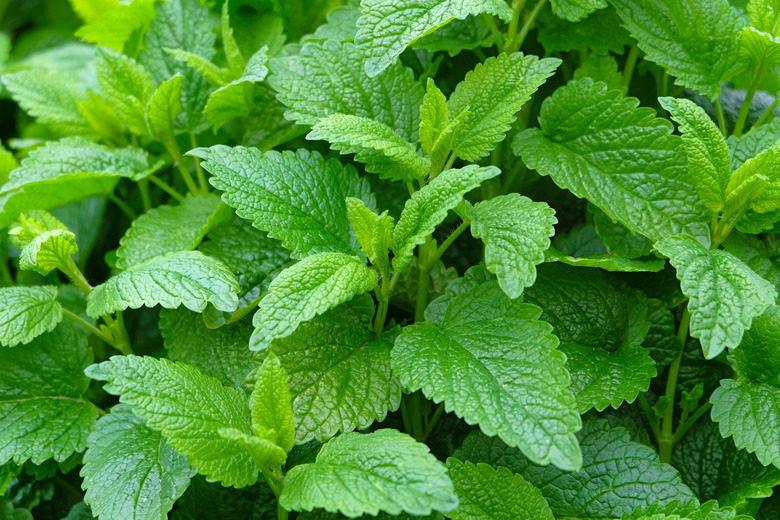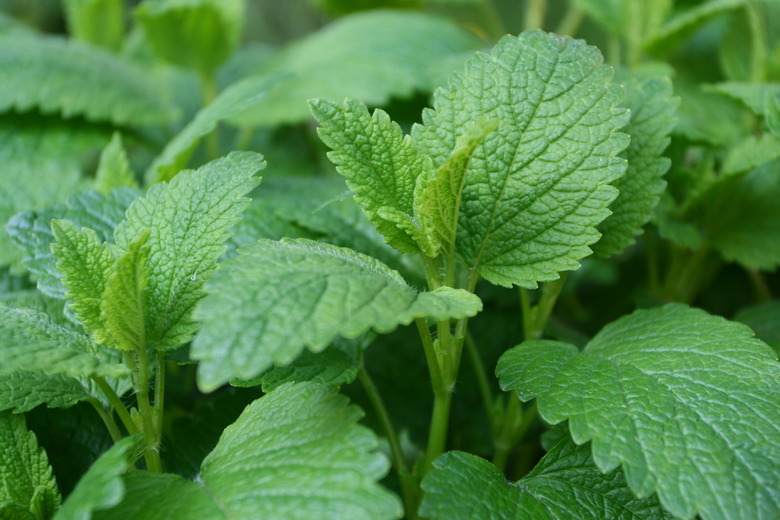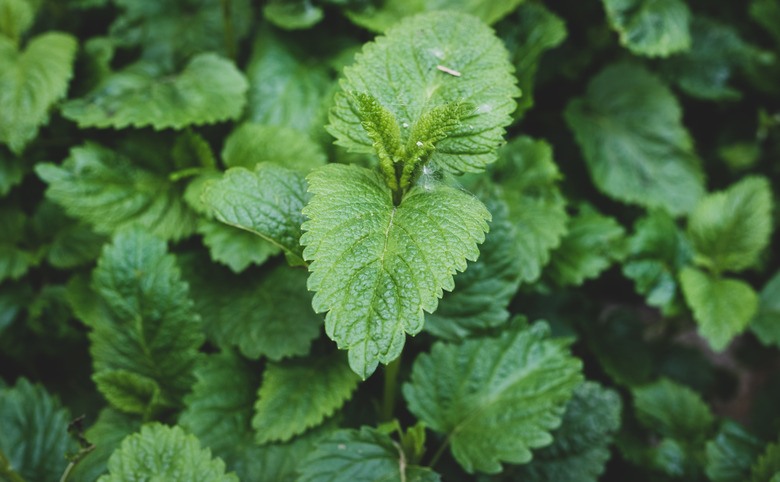How To Grow Lemon Balm
Lemon balm (Melissa officinalis, USDA zones 3-7) is an upright perennial herb that has been used for culinary and medicinal purposes for centuries. The plant grows in small clumps of branched stems up to 36 inches tall, developing small white or cream-colored flowers in summer and fall.
Lemon balm fits right in as a member of the mint family (Lamiaceae) with its deep-green, notched leaves, though it can easily be differentiated from other mint plants by its delightful, lemony scent. You don't need to be a great gardener to experience the flavor and scent of fresh lemon balm because these plants are easy to grow in just about all conditions.
Best Uses for Lemon Balm
Lemon balm's citrus-y scent is perfect for a variety of uses, including:
- Lemon balm's lemon-scented leaves are perfect for adding a zesty
splash to hot and cold drinks, particularly herbal tea. - You can also use lemon balm to add a tasty zing to
salads, dips, soft cheeses, cooked vegetables, fruits, salad dressings, meats,
shellfish and poultry. Other herbs that pair well with the flavor include oregano,
dill and parsley. - Drying can preserve much of the scent and flavor of lemon balm, and these dried leaves make an excellent addition to potpourris.
- Also known as balm mint, English balm, garden balm, heart's delight, honey plant, Melissa and sweet balm, lemon balm has been used medicinally for centuries. Whether used as an essential oil, tincture, capsule, concentrate or medicinal tea, it is reported to help anxiety, insomnia and indigestion and may even help heal cold sores.
Like other members of the mint family, lemon balm quickly sprawls away from the area where it is planted, so it should be grown either in pots where it can be contained or in areas where it won't encroach on other plants. Lemon balm spreads in two ways: by seeds and by rhizomes. If you want to stop the plant from becoming invasive, pinch off the tops of the plant before it flowers. Be sure to remove any unwanted lemon balm plants as soon as possible that sprout from the rhizomes.
Lemon balm is often grown in a vegetable or herb garden where its pungent scent helps attract honeybees, making it fantastic for companion planting near any plant that requires bees for pollination. Because it requires well-draining soil, it tends to do well on hills, where its large root system can also help prevent erosion. It can also provide an attractive, aromatic addition to an ornamental garden, especially if you grow a variegated cultivar like Aurea, which grows 4 feet tall and features dark-green leaves with bright-yellow highlights.
Before growing lemon balm, spend some time familiarizing yourself with the different cultivars. If you're looking for lemon balm leaves with a strong scent, you can't go wrong with Limoncella, as it has the strongest scent, which is why it too makes a good insect repellent.
When it comes to how much to grow, you'll probably want four plants for cooking or six to 12 plants if you want to make teas or dry the leaves to preserve them.
How to Grow Lemon Balm
Starting Lemon Balm From Seed
Lemon balm is easy to grow from seed, and this is the most cost-effective way to grow the herb as well:
- Sow lemon balm seeds outdoors after the last frost has passed
- After the seeds sprout, thin out your plants so they are 8 inches
apart. - After the plants mature, thin again so each plant has 20
inches of space in each direction. - If you grow the lemon balm in a pot, choose one that is 8 inches deep and equally wide. Plants grown in containers can be put outside after the last frost and should be taken into an unheated garage or patio for protection during the winter.
Starting Lemon Balm From a Seedling
If you're planning on starting your seeds indoors, plan on sowing them about two months before the last frost date in your area:
- Simply sprinkle the seeds on top of some potting soil and leave it in a sunny area. They need light to grow, so do not cover the pots or add more than a sprinkle of soil on top of the seeds.
- Add just enough water to ensure you have moist soil but be sure not to overwater. In these conditions, it should take around 10 days to germinate, and seeds will sprout quickest in temperatures between 65 and 70 degrees Fahrenheit.
- Transplanting should take place about two months after the sowing. Harden off
the seedlings prior to planting by taking them outside for a few hours each day for
a few weeks before your planting date. - Plant seedlings 20 inches apart and water immediately.
- When the
plants have flowered, cut them back to half their size in fall to encourage a
second crop of leaves within a month. This will also prevent them from becoming
overgrown.
In What Zone Does Lemon Balm Grow Best?
Lemon balm does best in USDA hardiness zones 3 to 7, as it prefers cool weather over heat and humidity. In fact, while it can survive cold temperatures down to -20 degrees, it is only moderately heat tolerant. In zone 7, it can survive all the way through the end of November. If you live somewhere particularly cold and snowy, consider growing the plants in pots that can be taken into an unheated garage or patio during the winter.
When Should You Plant Lemon Balm?
When starting plants indoors to be transplanted outside, begin two months before the last frost date. Transplanting should take place after the last frost between late March and mid-April for most areas.
When planting directly outdoors, it is best to plant after the last frost date or to wait until late summer or fall. When growing the plant in pots, start indoors before the last frost, outdoors after the last frost or in late summer or fall.
Soil, Sunlight and Water Recommendations for Lemon Balm
Although lemon balm prefers well-draining, sandy loam soil, it can grow in just about any soil as long as it is not kept overly wet. Neutral soil with a pH between 6.7 and 7.3 is best. While it is not necessary, the plants will grow healthier if you incorporate a little compost in the soil before planting and side-dress the plants with it during the growing season. If you have poor growing soil, consider the cultivar Aurea, which tolerates poor soil better than other types.
Lemon balm likes full or partial sun. Being a cool-weather plant, if you live somewhere where it gets pretty warm in midsummer, the direct sun could damage your plants and cause them to lose color and flavor. In these areas, it's best to grow your plants in a location where they will be protected from the harsh midday sun.
It's important to keep the soil moist but not soaking wet. This means it should get regular, even watering, though lemon balm can be fairly drought-tolerant once it becomes well-established. Mulch can help maintain soil moisture.
How to Propagate Lemon Balm
Lemon balm can be grown from seed, cuttings or root divisions. Cuttings can be taken from established plants in the spring, summer or fall. In spring or summer, take a few inches from the soft tips of new growth. If you are taking cuttings in fall, take sprigs from stems close to the base that have not yet blossomed.
To propagate lemon balm through cuttings:
- Remove 2/3 of the leaves from the bottom of each sprig and
pinch the tips to prevent wilting. - To help encourage growth and to discourage
disease, dip the stems in rooting hormone before placing them in
well-draining soil mix. - Water immediately and place them out of direct sunlight.
- In
about a month, roots will take hold, but if the soil is kept at an even 70 to
75 degrees, this can happen even quicker. Before transplanting, harden off the
cuttings for a week by setting them in a bright area outside for a few hours
every day.
To propagate through root division, simply dig up some of the root clusters from an established plant during the growing season. Divide the roots into smaller pieces and replant. While this can be done at any time, the process will be quicker when it is done in cool weather.
How to Winterize Lemon Balm
Overall, this cold-weather-friendly plant does just fine in the winter, surviving even in temperatures as low as -20 degrees. However, if you live somewhere very cold where there is a lot of snow, you'll want to cut back the plant before winter takes hold. To do so, cut back the plant in late fall until there are only 2 inches of stem.
How to Harvest Lemon Balm
Once the plants reach 8 inches tall, they can be harvested. Use a garden pruner to snip off leaves and sprigs, taking care not to bruise the leaves. Older leaves that are lower on the plant have the strongest scent and taste. For best results with drying the herb, harvest before the plant flowers in midsummer and consider harvesting on a dry day to make drying the leaves a little quicker. While harvesting, be sure to remove any unhealthy leaves that are damaged or brown.
If you really love lemon balm, you can harvest up to 1/3 of the plant at once, cutting stems almost down to ground level. It's hard to overharvest lemon balm, and it can grow back multiple times in a season.
Use, freeze or dry leaves within two days of harvesting or they will turn black. Once dried, the leaves can be saved in an airtight container stored in a dark area for about six months before they start to lose their flavor.
Common Pests and Other Problems for Lemon Balm
Overall, lemon balm is a very hardy plant that is rarely affected by pests, and it actually repels many insects. It is sometimes attacked by aphids or spider mites, both of which can be removed with a hard stream from a hose or with insecticidal soap.
If the plant is looking stressed, it may be because it was allowed to overgrow. This can be remedied by simply cutting the plant back, leaving only a few inches above ground. Within a month, it should regrow much of the foliage.
Common Diseases for Lemon Balm
Just as lemon balm is largely resistant to pests, it is also resistant to most diseases. It can, however, fall victim to a few fungal diseases, including:
- verticillim wilt
- mint rust
- powdery mildew
- septoria
leaf spot
All of these diseases can be minimized by not overwatering and providing enough space between plants to encourage good air circulation.
If you have a serious problem with any fungal disease, you can always cut back the plants until only 2 inches of stem are visible above the ground. By the time they grow back, the infection will have died off.


